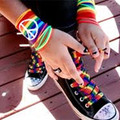 Néhány kutató úgy véli, a másik személynek küldött üzeneteink 90%-ban nem szavainkból, hanem gesztusokból, arckifejezésekből és testnyelvből állnak. Az egyetlen gond, hogy vannak gesztusok, és nem verbális jelek, melyeket különböző kultúrákban különbözőképpen értelmeznek. Ezek a kultúrák konfliktusához (vagy akár harcához) vezethetnek.
Néhány kutató úgy véli, a másik személynek küldött üzeneteink 90%-ban nem szavainkból, hanem gesztusokból, arckifejezésekből és testnyelvből állnak. Az egyetlen gond, hogy vannak gesztusok, és nem verbális jelek, melyeket különböző kultúrákban különbözőképpen értelmeznek. Ezek a kultúrák konfliktusához (vagy akár harcához) vezethetnek.
Nézzük, mely gyakran használt jelzések okozhatnak félreértést!
Body Language, Gestures and Culture
As for the opinion of some researchers, close to 90% of the message we send to other human beings is non-verbal: gestures, facial expressions and body language. The only problem is that some gestures and non-verbal signs are understood in other way in different cultures, what may lead to culture clash and conflicts (if not fight). Let’s see which frequently used signs can cause misunderstanding.
A-OK
 Generally, the a-OK is just that, a sign of approval. But, in several middle and southern European countries, with the exception of Spain and Portugal, the gesture is decidedly offensive, telling the recipient that he/she is a nobody, a zero (0). The meaning is even worse in Brazil, telling the other person he/she is an asshole. The gesture is also extremely offensive in Turkey where it is used in connection with homosexuality. In Japan it's relatively harmless as it means no more and no less than simply "money".
Generally, the a-OK is just that, a sign of approval. But, in several middle and southern European countries, with the exception of Spain and Portugal, the gesture is decidedly offensive, telling the recipient that he/she is a nobody, a zero (0). The meaning is even worse in Brazil, telling the other person he/she is an asshole. The gesture is also extremely offensive in Turkey where it is used in connection with homosexuality. In Japan it's relatively harmless as it means no more and no less than simply "money".
When the circle is placed over the nose with the nose peeking out between thumb and index finger, it's a signal to indicate that a person is drunk.
Cheek Kissing
 Kissing the cheek is a very common form of greeting in Southern Europe and Latin America. Sometimes both cheeks are kissed, sometimes only one cheek is touched lightly by the lips. The kisses are accompanied by a hand shake or by putting one's hands on the other person's shoulders. Women often air-kiss to avoid leaving a trace of lipstick on the greeted person's cheek. Although cheek kissing is a sign of affection, it can also be conceived as an invasion of private space.
Kissing the cheek is a very common form of greeting in Southern Europe and Latin America. Sometimes both cheeks are kissed, sometimes only one cheek is touched lightly by the lips. The kisses are accompanied by a hand shake or by putting one's hands on the other person's shoulders. Women often air-kiss to avoid leaving a trace of lipstick on the greeted person's cheek. Although cheek kissing is a sign of affection, it can also be conceived as an invasion of private space.
In South East Asia and any other country influenced by Muslim or Hindu culture, cheek kissing, especially a woman, is offensive and must be avoided.
Nodding
 Another body language signal involving the head is nodding. The head is bobbed vertically once or several times and the gesture generally convey approval and consent. However, in Bulgaria and Thailand, nodding means the opposite: a very definite "no". Vigorous nodding usually means strong approval, whereas nodding slowly several times can mean: "Maybe, but I'll have to think about it."
Another body language signal involving the head is nodding. The head is bobbed vertically once or several times and the gesture generally convey approval and consent. However, in Bulgaria and Thailand, nodding means the opposite: a very definite "no". Vigorous nodding usually means strong approval, whereas nodding slowly several times can mean: "Maybe, but I'll have to think about it."
Sign of the Horn
 The "corno" sign is made by raising the hand with index finger and little finger extended and the rest of the fingers clenched. It basically has two meanings: in the majority of the world and in Mediterranean countries it's a vulgar sign with a sexual implication, indicating that someone has been cheated on. In Buddhism and Hindu cultures however, the sign is made to ward off evil. The horn sign also has significance in American sports, particularly baseball, where the extended arm is rotated to signal "two outs".
The "corno" sign is made by raising the hand with index finger and little finger extended and the rest of the fingers clenched. It basically has two meanings: in the majority of the world and in Mediterranean countries it's a vulgar sign with a sexual implication, indicating that someone has been cheated on. In Buddhism and Hindu cultures however, the sign is made to ward off evil. The horn sign also has significance in American sports, particularly baseball, where the extended arm is rotated to signal "two outs".
Thumbs Up
 The origin of thumbs up and thumbs down is not clearly established, but is thought to date back to Roman times and the gladiator fights, when the crowds signaled whether a gladiator should live or die.
The origin of thumbs up and thumbs down is not clearly established, but is thought to date back to Roman times and the gladiator fights, when the crowds signaled whether a gladiator should live or die.
In modern times, the thumb up signifies approval and success, whereas the thumb down conveys the opposite. The thumb up sign is another example for how the same gesture can have a very different meaning in other cultures.
Thumbs up in Middle Eastern countries, Iran, Iraq and Thailand, is an extremely obscene gesture. In India, thumbs up combined with a wagging of the fist means: "I doubt that that'll work".
Thumbs up is an important sign in diving, where it doesn't mean: "everything is OK", but "stop the dive and ascend".
Note also: Another hand gesture with a demeaning significance is forming the letter "L" by extending thumb and index finger at a 90 degree angle. It stands for "loser" at least in cultures where English is the common language.
V – Sign
 Another letter formed by fingers is the "V". Legend has it that the V sign originates from the 100 Year War, when the French vowed to cut off English longbowmen's middle fingers, but as the English won the war, they raised their fingers in the V sign to show that the shooting fingers were still intact.
Another letter formed by fingers is the "V". Legend has it that the V sign originates from the 100 Year War, when the French vowed to cut off English longbowmen's middle fingers, but as the English won the war, they raised their fingers in the V sign to show that the shooting fingers were still intact.
Making the V sign with the palm turned inward is, particularly in the UK, an offensive sign. It was Winston Churchill after World War II, who first used the V sign for victory and success, but with the palm turned outward. Since then it has been used in that context. In the US it's generally a sign of success, often made with both arms raised.
Smiles
 Smiles, a powerful tool of body language, can be used to express a great variety of meaning. A broad smile exposing the teeth is the strongest form of showing joy, friendliness, politeness and approval. However, if the smile does not reach the eyes, it expresses insincerity. Exposed teeth can also backfire. In ancient times, man snarled when angry, exposing his canine teeth. Legend has it that many a missionary lost his life when smiling at indigenous tribes with his lips parted, because it was understood as a sign of hostility and pending attack.
Smiles, a powerful tool of body language, can be used to express a great variety of meaning. A broad smile exposing the teeth is the strongest form of showing joy, friendliness, politeness and approval. However, if the smile does not reach the eyes, it expresses insincerity. Exposed teeth can also backfire. In ancient times, man snarled when angry, exposing his canine teeth. Legend has it that many a missionary lost his life when smiling at indigenous tribes with his lips parted, because it was understood as a sign of hostility and pending attack.
A lop sided smile with only one corner of the mouth drawn up, expresses doubt and even cynicism or sarcasm.
Eye Contact
 Establishing eye contact is meant to create a link of trust between people. It expresses just the opposite in Japan, when used during greeting. Constant eye contact can be used to make the other person nervous.
Establishing eye contact is meant to create a link of trust between people. It expresses just the opposite in Japan, when used during greeting. Constant eye contact can be used to make the other person nervous.
Useful Vocabulary
| English | Hungarian |
|---|---|
| approval | elfogadás, egyetértés |
| offensive | támadó |
| recipient | fogadó fél, címzett |
| an asshole | seggfej |
| harmless | ártalmatlan |
| peek out | kikukucskál |
| accompany | társul, kísér |
| trace of lipstick | rúzsnyom |
| affection | vonzalom |
| invasion of personal space | behatolás a személyes térbe |
| bob | fel-le mozog |
| vertically | függőlegesen |
| consent | beleegyezés |
| vigorous | élénk |
| extend | (ki)nyújt |
| clench | összeszorít |
| indicate | jelez |
| cheat on | megcsal vkit |
| ward off | távol tart |
| evil | gonosz |
| convey | közvetít, közöl |
| wag | ide-oda mozgat, csóvál |
| fist | ököl |
| ascend | emelkedik |
| demeaning | lealacsonyító, megalázó |
| significance | jelentés |
| vow | megfogad |
| longbowman | íjász |
| intact | érintetlen |
| inward | befelé |
| outward | kifelé |
| insincerity | őszintétlenség |
| expose | mutogat, felfed |
| backfire | visszafelé sül el |
| snarl | vicsorog |
| canine teeth | szemfog |
| missionary | misszionárius |
| indigenous tribe | bennszülött törzs |
| hostility | ellenséges érzelem |
| pending attack | feltételezett támadás |
| lop-sided | féloldalas |
Exercises:
1. In which country/countries the gesture of A-Ok is decidedly offensive, telling the recipient that he/she is a nobody, a zero (0)?
- a. In Haiti.
- b. In several middle and southern European countries, with the exception of Spain and Portugal.
- c. In Norway and Switzerland.
2. In which country/countries cheek kissing, especially a woman, is offensive and must be avoided and why?
- a. In Hungary, because of the influence of Catholic Religion.
- b. In South East Asia and any other country, because of the influence of Muslim or Hindu culture.
- c. In Canada, because of the influence of ice-hockey.
3. In which country/countries does nodding mean a very definite "no"?
- a. In Romania.
- b. In Slovakia.
- c. In Bulgaria and Thailand.
4. In which sport(s) is the extended arm rotated to signal "two outs."
- a. In American sports, particularly baseball.
- b. In javelin throwing.
- c. In valley ball.
5. What does forming the letter "L" by extending thumb and index finger at a 90 degree angle mean?
- a. love you
- b. lottery winner
- c. loser
6. Who was the famous politician after World War II, who first used the V sign for victory and success, but with the palm turned outward?
- a. Adolf Hitler
- b. Winston Churchill
- c. Joseph Stalin
Key
1. B
2. B
3. C
4. A
5. C
6. B





